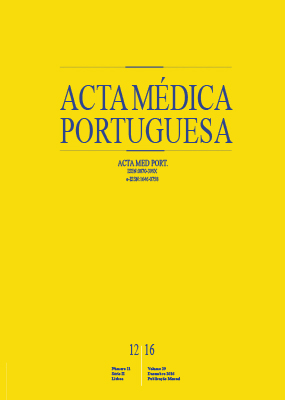An Objective Structured Clinical Exam to Assess Semiology Skills of Medical Students
DOI:
https://doi.org/10.20344/amp.8407Keywords:
Education, Medical, Undergraduate, Educational Measurement, Medical History Taking, Physical Examination, Portugal, Reproducibility of ResultsAbstract
Introduction: Mastery of history taking and physical exam skills is a key competence of medical students. Objective Structured Clinical Examinations are the gold standard to assess these competencies, but their implementation in Portugal is poorly documented. We describe the implementation and our seven years experience with a high-stakes Objective Structured Clinical Examination to assess these skills in the School of Medicine, University of Minho.
Material and Methods: Our Objective Structured Clinical Examination is in place since 2010 and has been subject to continuous improvements, including the adoption of a standard setting procedure and an increase in the number of stations.
Results: Grades in our exam are well distributed and discriminate among students. History taking grades are lower and have remained stable throughout the years while physical examination scores have risen. The exam is reliable, with internal consistency above 0.45 and a G-coefficient of 0.74. It is also feasible, with a total testing time of approximately 20 hours for 140 students, and the involvement of 18 standardized patients and 18 faculty assessors. More importantly, it was able to engage the students, who recognize its importance.
Discussion: The most important validity criterion of our, and any Objective Structured Clinical Examination, would be predictive validity,
the ability to predict the performance of students in the clinical context.
Conclusion: Our approach to a high-stakes Objective Structured Clinical Examination shows that it is feasible, reliable, valid and fair and can be implemented with success in the Portuguese setting.
Downloads
Downloads
Published
How to Cite
Issue
Section
License
All the articles published in the AMP are open access and comply with the requirements of funding agencies or academic institutions. The AMP is governed by the terms of the Creative Commons ‘Attribution – Non-Commercial Use - (CC-BY-NC)’ license, regarding the use by third parties.
It is the author’s responsibility to obtain approval for the reproduction of figures, tables, etc. from other publications.
Upon acceptance of an article for publication, the authors will be asked to complete the ICMJE “Copyright Liability and Copyright Sharing Statement “(http://www.actamedicaportuguesa.com/info/AMP-NormasPublicacao.pdf) and the “Declaration of Potential Conflicts of Interest” (http:// www.icmje.org/conflicts-of-interest). An e-mail will be sent to the corresponding author to acknowledge receipt of the manuscript.
After publication, the authors are authorised to make their articles available in repositories of their institutions of origin, as long as they always mention where they were published and according to the Creative Commons license.









